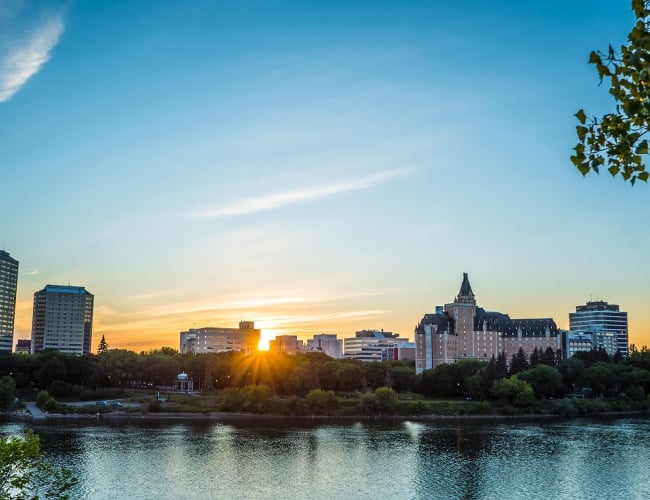
The Trails of 1885
Take a step back through time to the dramatic days of 1885 and the North-West Rebellion on this fascinating day trip from Saskatoon.
Embrace the spirit of truth and reconciliation as you explore pivotal sites related to the historic conflict, including the town of Duck Lake, Fort Carlton Provincial Park, and the 19th-century Métis settlement at Batoche National Historic Site.
This violent, five-month insurgency saw the Métis Peoples and their Indigenous allies take up arms against the Canadian government in defense of their land, rights, and survival. The brutal conflict left hundreds dead and led to the eventual defeat of the rebels by the Canadian militia, the subjugation of Plains Indigenous Peoples in Canada, and the trial, conviction, and execution by hanging of leader Louis Riel.
We invite you to go deeper into this painful yet important chapter in the history of this land, learn about its impacts on present-day Indigenous communities, and join us as we work toward a future in which truth is understood and reconciliation made possible.
Morning
Your journey begins an hour northeast of Saskatoon at Batoche National Historic Site. Nestled on the banks of the South Saskatchewan River, this former Métis settlement played a pivotal role in the final days of the North-West Rebellion as the site of Louis Riel’s last stand against the Canadian militia.
Today, the site is open from mid-May through mid-September and features historic buildings and a visitor’s centre. Knowledgeable guides and costumed interpreters transport you back in time to 19th-century Métis settler life at Batoche, while a wheelchair-accessible shuttle service ensures barrier-free access to this important historical site.
Midday
After your tour, it’s on to the town of Duck Lake, located about a half-hour drive from Batoche. The town is home to the Duck Lake Murals, an outdoor public art collection featuring prominent figures and events in the North-West Rebellion. Pack a picnic lunch or pop into one of Duck Lake’s local restaurants to fuel up for an afternoon of continued learning and exploration.
The nearby Duck Lake Regional Interpretive Centre offers helpful information for visitors, including immersive exhibits that tell the stories of the Willow Cree First Nation, Métis People, and colonial settlers of this land. Climb the spiral staircase up to the gallery’s 24-metre-high tower, where you’ll be greeted by sweeping, panoramic views, along with interpretive installations explaining the significance of what transpired here. Before leaving Duck Lake, make a stop to pay your respects at the historic cemetery of All Saints Anglican Church, the final resting place of several prominent Rebellion fighters.
Afternoon
After you’ve finished your tour of Duck Lake, it’s a short 20-minute drive to neighbouring Fort Carlton Provincial Park. Along the way, you’ll pass the site where Treaty Six was first signed on on August 23, 1876 between the Canadian government and the Plains, Wood Cree, Nakota, Saulteaux, and Dene peoples — enshrining the nations’ rights and obligations to one another for as long as the sun shines and grass grows.
Once a Hudson's Bay Company fur trading post, historic Fort Carlton served as the main base of operations for the North-West Mounted Police during the dramatic events of 1885, before it was abandoned and burned to the ground following a hasty evacuation after the Battle of Duck Lake. Today, the fort has been restored and designated a National Historic Site.
Explore the reconstructed historic buildings on a guided tour, and learn about the heyday of the fur trade, along with the fort’s important role in the events of the North-West Rebellion, through interactive exhibits. When you’re done, it’s time to hit the road and head back to the city while you reflect on this important chapter in Canadian history.




